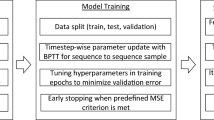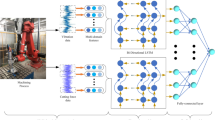Abstract
Tool wear and faults will affect the quality of machined workpiece and damage the continuity of manufacturing. The accurate prediction of remaining useful life (RUL) is significant to guarantee the processing quality and improve the productivity of automatic system. At present, the most commonly used methods for tool RUL prediction are trained by history fault data. However, when researching on new types of tools or processing high value parts, fault datasets are difficult to acquire, which leads to RUL prediction a challenge under limited fault data. To overcome the shortcomings of above prediction methods, a deep transfer reinforcement learning (DTRL) network based on long short-term memory (LSTM) network is presented in this paper. Local features are extracted from consecutive sensor data to track the tool states, and the trained network size can be dynamically adjusted by controlling time sequence length. Then in DTRL network, LSTM network is employed to construct the value function approximation for smoothly processing temporal information and mining long-term dependencies. On this basis, a novel strategy of Q-function update and transfer is presented to transfer the deep reinforcement learning (DRL) network trained by historical fault data to a new tool for RUL prediction. Finally, tool wear experiments are performed to validate effectiveness of the DTRL model. The prediction results demonstrate that the proposed method has high accuracy and generalization for similar tools and cutting conditions.







Similar content being viewed by others
Data availability
The data sets supporting the results of this article are included within the article.
References
Liao X, Zhou G, Zhang Z, Lu J, Ma J (2019) Tool wear state recognition based on GWO–SVM with feature selection of genetic algorithm. Int J Adv Manuf Technol 104(1-4):1051–1063
Aghazadeh F, Tahan A, Thomas M (2018) Tool condition monitoring using spectral subtraction and convolutional neural networks in milling process. Int J Adv Manuf Technol 98(9-12):3217–3227
Wang G, Qian L, Guo Z (2012) Continuous tool wear prediction based on Gaussian mixture regression model. Int J Adv Manuf Technol 66(9-12):1921–1929
Si X, Wang W, Hu C (2013) A Wiener-process-based degradation model with a recursive filter algorithm for remaining useful life estimation. Mech Syst Signal Process 35(1-2):219–237
Yan H, Zhou J, Pang C (2015) Gamma process with recursive MLE for wear PDF prediction in precognitive maintenance under aperiodic monitoring. Mechatronics 31:68–77
Wang J, Wang P, Gao R (2015) Enhanced particle filter for tool wear prediction. J Manuf Syst 36:35–45
Li C, Sanchez R, Zurita G (2016) Gearbox fault diagnosis based on deep random forest fusion of acoustic and vibratory signals. Mech Syst Signal Process 76-77:283–293
Javed K, Gouriveau R, Li X, Zerhouni N (2016) Tool wear monitoring and prognostics challenges: a comparison of connectionist methods toward an adaptive ensemble model. J Intell Manuf 29(8):1873–1890
Dou J, Xu C, Jiao S, Li B, Zhang J, Xu X (2019) An unsupervised online monitoring method for tool wear using a sparse auto-encoder. Int J Adv Manuf Technol 106:2493–2507
Sun C, Wang P, Yan R (2019) Machine health monitoring based on locally linear embedding with kernel sparse representation for neighborhood optimization. Mech Syst Signal Process 114:25–34
Widodo A, Yang B (2007) Support vector machine in machine condition monitoring and fault diagnosis. Mech Syst Signal Process 21(6):2560–2574
Chen B, Chen X, Li B (2011) Reliability estimation for cutting tools based on logistic regression model using vibration signals. Mech Syst Signal Process 25(7):2526–2537
Karandikar J (2019) Machine learning classification for tool life modeling using production shop-floor tool wear data. Procedia Manuf 34:446–454
Kong D, Chen Y, Li N, Tan S (2016) Tool wear monitoring based on kernel principal component analysis and v-support vector regression. Int J Adv Manuf Technol 89(1-4):175–190
Zhang C, Zhang H (2016) Modelling and prediction of tool wear using LS-SVM in milling operation. Int J Comput Integr Manuf 29(1):76–91
Kong D, Chen Y, Li N (2018) Gaussian process regression for tool wear prediction. Mech Syst Signal Process 104:556–574
Kong D, Chen Y, Li N (2017) Force-based tool wear estimation for milling process using Gaussian mixture hidden Markov models. Int J Adv Manuf Technol 92(5-8):2853–2865
Zhou Y, Wang T (2018) ENN-based recognition method for tool cutting state. J Comput Sci 27:418–427
Serin G, Sener B, Ozbayoglu A, Unver H (2020) Review of tool condition monitoring in machining and opportunities for deep learning. Int J Adv Manuf Technol 109:953–974
Tao Z, An Q, Liu G, Chen M (2019) A novel method for tool condition monitoring based on long short-term memory and hidden Markov model hybrid framework in high-speed milling Ti-6Al-4V. Int J Adv Manuf Technol 105(7-8):3165–3182
Wang J, Ma Y, Zhang L, Gao R, Wu D (2018) Deep learning for smart manufacturing: methods and applications. J Manuf Syst 48:144–156
Xu X, Wang J, Ming W (2020) In-process tap tool wear monitoring and prediction using a novel model based on deep learning. Int J Adv Manuf Technol 112(1-2):453–466
Jia F, Lei Y, Lin J, Zhou X, Lu N (2016) Deep neural networks: a promising tool for fault characteristic mining and intelligent diagnosis of rotating machinery with massive data. Mech Syst Signal Process 72-73:303–315
Shao H, Jiang H, Zhang H, Duan W, Liang T, Wu S (2018) Rolling bearing fault feature learning using improved convolutional deep belief network with compressed sensing. Mech Syst Signal Process 100:743–765
Wu X, Li J, Jin Y, Zheng S (2020) Modeling and analysis of tool wear prediction based on SVD and BiLSTM. Int J Adv Manuf Technol 106(9-10):4391–4399
Zhao M, Kang M, Tang B, Pecht M (2018) Deep residual networks with dynamically weighted wavelet coefficients for fault diagnosis of planetary gearboxes. IEEE Trans Ind Electron 65:4290–4300
Arulkumaran K, Deisenroth M, Brundage M, Bharath A (2017) deep reinforcement learning: a brief survey. IEEE Signal Process Mag 34(6):26–38
Silver D, Huang A, Maddison C (2016) Mastering the game of Go with deep neural networks and tree search. Nature 529:484–489
Wang Y, Fang Y, Lou P, Yan J, Liu N (2020) Deep reinforcement learning based path planning for mobile robot in unknown environment. J Phys Conf Ser:1576
Liu Q, Liu Z, Xu W, Tang Q (2019) Human-robot collaboration in disassembly for sustainable manufacturing. Int J Prod Res 57:4027–4044
Yang H, Zhong W, Chen C (2020) Deep reinforcement learning based energy efficient resource management for social and cognitive internet of things. IEEE Internet Things J 7:5677–5689
Min M, Xiao L, Chen Y (2019) Learning based computation offloading for IoT devices with energy harvesting. IEEE Trans Veh Technol 68:1930–1941
Luo S (2020) Dynamic scheduling for flexible job shop with new job insertions by deep reinforcement learning. Appl Soft Comput 91:106208
Hu L, Liu Z, Hu W (2020) Petri-net-based dynamic scheduling of flexible manufacturing system via deep reinforcement learning with graph convolutional network. J Manuf Syst 55:1–14
Ding Y, Ma L, Ma J (2019) Intelligent fault diagnosis for rotating machinery using deep Q-network based health state classification: A deep reinforcement learning approach. Adv Eng Inform:42
Mnih V, Kavukcuoglu K, Silver D (2015) Human-level control through deep reinforcement learning. Nature 518:529–533
He Q, Kong F, Yan R (2007) Subspace-based gearbox condition monitoring by kernel principal component analysis. Mech Syst Signal Process 21(4):1755–1772
Zhang Z, Li H, Meng G, Tu X, Cheng C (2016) Chatter detection in milling process based on the energy entropy of VMD and WPD. Int J Mach Tools Manuf 108:106–112
Hong Y-S, Yoon H-S, Moon J-S, Cho Y-M, Ahn S-H (2016) Tool-wear monitoring during micro-end milling using wavelet packet transform and Fisher’s linear discriminant. Int J Precis Eng Manuf 17(7):845–855
Funding
This work was supported in part by the National Key R&D Program of China under Grant 2018YFB1308300.
Author information
Authors and Affiliations
Contributions
Jiachen Yao performed the data analyses and wrote the manuscript; Baochun Lu contributed to the conception of the study; Junli Zhang performed the experiment and helped perform the analysis.
Corresponding author
Ethics declarations
Ethics approval
NA.
Consent to participate
NA.
Consent to publish
Written informed consent for publication was obtained from all participants.
Competing interests
The authors declare no competing interests.
Additional information
Publisher’s note
Springer Nature remains neutral with regard to jurisdictional claims in published maps and institutional affiliations.
Rights and permissions
About this article
Cite this article
Yao, J., Lu, B. & Zhang, J. Tool remaining useful life prediction using deep transfer reinforcement learning based on long short-term memory networks. Int J Adv Manuf Technol 118, 1077–1086 (2022). https://doi.org/10.1007/s00170-021-07950-2
Received:
Accepted:
Published:
Issue Date:
DOI: https://doi.org/10.1007/s00170-021-07950-2




